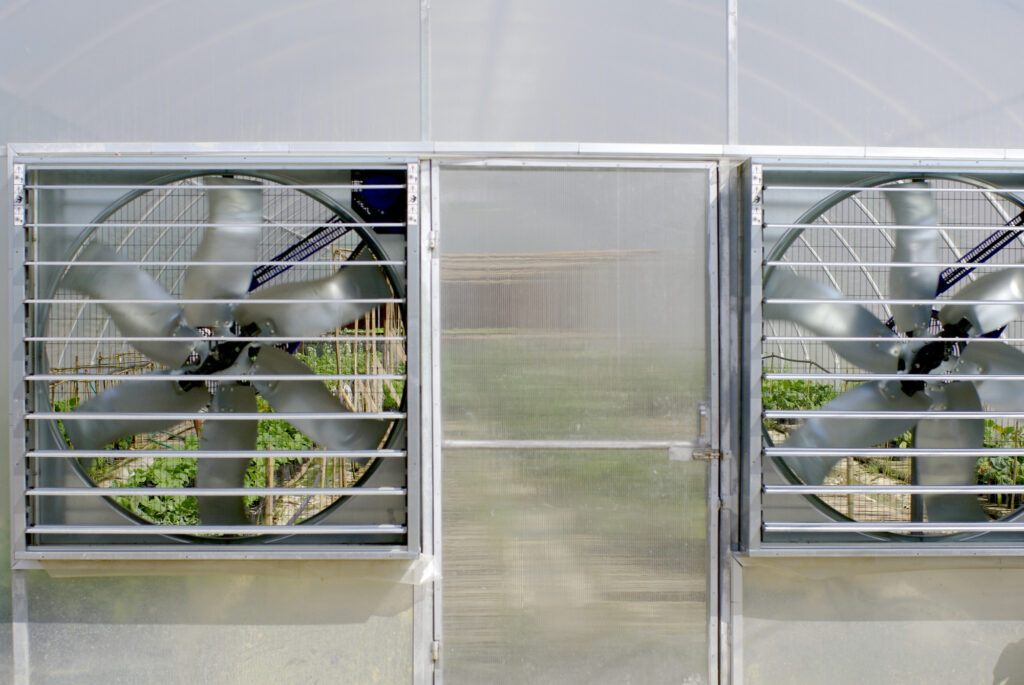Why Does a Well-Designed Greenhouse Have an Exhaust Fan?
For the simple reason that an exhaust fan for a greenhouse plays a critical role in proper building ventilation.
It’s for this reason that you first need to understand the basics of ventilation. This way, you’ll recognize the importance of installing an exhaust fan in your facility.
There are four main functions of ventilation (we’ll give you a more detailed explanation of each below):
- Temperature regulation
- A continuous flow of fresh air
- Pest control and prevention
- Pollination
Exhaust fans have a part to play in all four, making them an obvious must-have for greenhouses. Without these fans, your plants won’t grow. They’ll wilt away and you’ll end up with a jungle of a brown mess.
Let’s take a closer look at how they help each of the four ventilation processes.

Keeping Things Cool with Improved Temperature Regulation
Optimal greenhouse temperatures vary, although the range should stay within 50-68 degrees Fahrenheit. More than this, your greenhouse can become one giant oven.
Not only will excess heat stump your plants’ growth; but it’ll also lead to wilting and ultimately, the death of your greens.
This is why you need proper ventilation in your greenhouse. Especially during the summer season, when July hits as high as 76 degrees Fahrenheit on average.
Many plants, such as tomatoes, have high heat sensitivity. This means that when the temperatures increase beyond their limits, they’ll stop growing, wilt, and die. That’s because the best temperature for plants to achieve optimum photosynthesis is only between 70 and 72 degrees Fahrenheit.
With vents in strategic installation points, you can maintain even temperatures throughout the greenhouse. But this isn’t enough of a solution, as the vents can only let so much excess heat escape through them.
Exhaust fans boost the amount of heat allowed to escape through the ventilation. As they push stale air out of your facility, they also let cool, fresh air enter.
Also, during much hotter days, consider an evaporative cooler. This equipment working side by side with your exhaust fans helps make bringing down the temp faster and more effective.
Constant Supply of Fresh Air for Your Greens
Did you know that a greenhouse measuring 30′ x 100′ houses a whopping 1 to 1.5 tons of air? Even if you have a smaller facility, there’s still a lot of air present in it (about a pound for every square foot).
The thing is, you need to make sure this air moves on a constant basis, seeing as your plants require even temperature. There’s also the fact that a continuous supply of fresh air means delivering adequate carbon dioxide to your greens.
Without good airflow, your flora won’t have any source of CO2 for sugar production. Without sugar, which they use as food, you can expect them to starve and die.
Again, proper ventilation lets fresh air enter your greenhouse. But to keep the air moving about, it’s best you have exhaust fans that push and pull the air in and out of the structure. With the right exhaust fan size (which you should base on the size of your greenhouse), you can ensure air circulates throughout the space to reach all your plants.
To ensure exhaust fan efficiency, the fan’s capacity should be twice as large as your greenhouse’s floor area. So, for a 30′ x 100′ greenhouses, you need only to multiply it by two. That means you should get a fan with a capacity of 6,000 cubic feet per minute.
Keeping Pests (and Diseases) Out
Boosting ventilation in your greenhouse with exhaust fans helps protect your greens from plant-killing diseases and pests. That’s because aside from keeping optimal temperatures, exhaust fans also aid in proper humidity management.
Controlling humidity is key to plant disease management. In fact, excess humidity is the number one cause of disease in plants.
It’s for this reason you need to keep the plant canopy dry. Allow your plants’ leaves to cool down too much, and condensation will already occur.
Once this happens, disease-harboring organisms can start attacking your plants. Think fungi, whitefly, blight, canker, and rotting.
To further improve ventilation and exhaust efficacy, consider investing in a humidity-measuring device. From there, you can better manage humidity based on temperature.
More Efficient Pollination and Reproduction
Outdoors, and wind allows for natural plant pollination. But since greenhouses don’t have this wind, you need to look for ideal substitutes for it. That’s what exhaust fans are for.
The fans’ air-moving properties gently shake the plants, letting them pollinate like in a typical outdoor setting. This is particularly crucial for self-pollinating plants, such as tomatoes.
As such, if you’re having problems with your plants not bearing fruit, take this as a sign you need to bring air flow rate up. Besides, the gentle movements caused by the fans’ airflow also promote the strengthening of the plants’ stems and roots.

